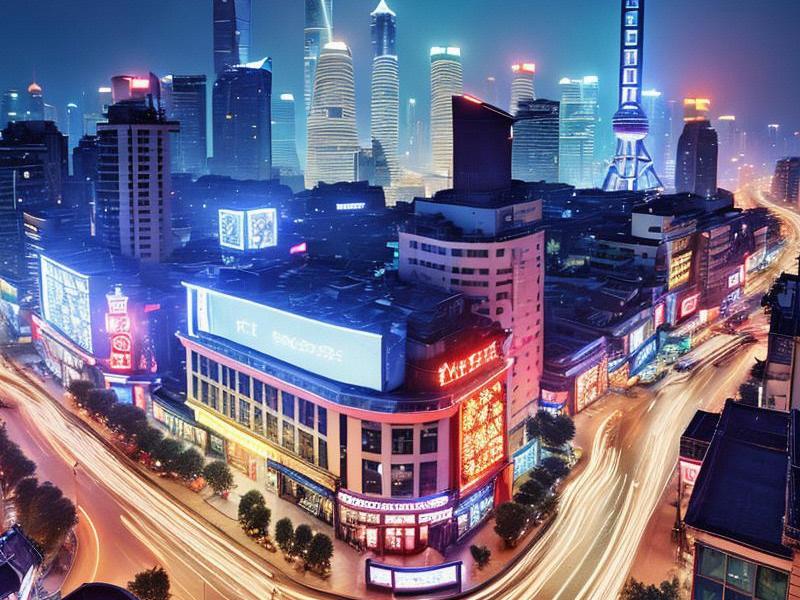This article delves into the thriving entertainment districts in Shanghai, exploring their cultural significance, economic contributions, and the evolving social dynamics they reflect. It examines how these districts have become a cornerstone of the city's nightlife, attracting both locals and tourists with their vibrant atmosphere and diverse offerings.

Shanghai, the bustling metropolis of China, has long been a symbol of modernity and progress. Among its many facets, the city's entertainment districts stand out as vibrant hubs of nightlife, where the pulse of the city beats strongest after dark. These districts, often referred to colloquially as "Shanghai's Entertainment St," have become a testament to the city's dynamic culture and its ability to blend tradition with modernity.
The concept of an entertainment district in Shanghai is not new. Historically, areas like the French Concession were known for their lively nightlife, with jazz bars, cabarets, and tea houses attracting patrons from all walks of life. However, the contemporary entertainment districts of Shanghai are a far cry from their predecessors, offering a more diverse and sophisticated range of activities.
One of the most prominent entertainment districts in Shanghai is the area around People's Square. This area has transformed over the years, with the construction of iconic buildings like the Shanghai Grand Theatre and the Shanghai Urban Planning Exhibition Center. The square itself is a major cultural landmark, surrounded by theaters, cinemas, and restaurants. At night, the area comes alive with the sounds of street performers, the glow of neon signs, and the hum of conversation from the numerous bars and clubs.
爱上海同城419 Another key player in Shanghai's entertainment scene is the Bund. Once a symbol of colonial Shanghai, the Bund has undergone a remarkable transformation in recent years. The waterfront promenade, lined with historical buildings, now hosts a variety of entertainment options. Luxury hotels and high-end restaurants have sprung up, alongside trendy bars and clubs that offer stunning views of the city skyline. The Bund has become a favorite destination for both locals and tourists seeking a mix of history, culture, and nightlife.
The emergence of new entertainment districts in Shanghai is also noteworthy. Areas like Xintiandi and Tianzifang have carved out their own niches, offering a blend of traditional Shanghainese culture and modern entertainment. Xintiandi, a pedestrian-only area, is known for its art galleries, boutique shops, and chic cafes. At night, the area transforms into a lively scene with live music, open-air dining, and a variety of bars. Tianzifang, on the other hand, is a maze of narrow alleys filled with artisan workshops, design stores, and cozy cafes. The area's unique charm and laid-back atmosphere make it a popular spot for those seeking a more intimate and authentic entertainment experience.
The economic impact of Shanghai's entertainment districts cannot be overstated. These areas contribute significantly to the city's GDP through tourism, dining, and entertainment. They attract millions of visitors annually, both from within China and abroad, generating substantial revenue for local businesses. The presence of luxury hotels, high-end restaurants, and exclusive clubs also indicates the growing disposable income of Shanghai's residents, reflecting the city's economic prosperity.
上海龙凤419
However, the rapid development of entertainment districts has also raised concerns. The influx of tourists and the commercialization of nightlife have led to overcrowding and rising property prices in some areas. There is also a growing concern about the impact of nightlife on local communities, with some residents complaining about noise pollution and the disruption of traditional lifestyles.
Despite these challenges, the entertainment districts of Shanghai continue to thrive, adapting to the changing needs and preferences of the city's residents. The rise of new technologies and social media has also played a significant role in shaping the nightlife scene. Apps and platforms that allow users to discover and book entertainment options have made it easier than ever to explore the city's vibrant nightlife.
爱上海 The cultural significance of Shanghai's entertainment districts cannot be overlooked. They serve as a microcosm of the city's diverse population, reflecting its rich history and dynamic culture. The blend of traditional Shanghainese elements with modern influences creates a unique atmosphere that is both familiar and exciting. These districts are not just places to party; they are cultural hubs where people can experience the essence of Shanghai.
Socially, the entertainment districts of Shanghai have become spaces for interaction and exchange. They bring together people from different backgrounds, creating opportunities for cultural exchange and social cohesion. The nightlife scene, with its emphasis on inclusivity and diversity, reflects the broader social trends in Shanghai, where traditional values coexist with modern aspirations.
In conclusion, the entertainment districts of Shanghai are a vibrant and integral part of the city's identity. They offer a unique blend of culture, history, and modernity, attracting visitors from around the world. While challenges such as overcrowding and commercialization persist, the districts continue to evolve, adapting to the changing dynamics of the city. As Shanghai continues to grow and develop, its entertainment districts will undoubtedly remain at the heart of the city's nightlife culture, serving as a testament to its enduring appeal and vitality.
The story of Shanghai's entertainment districts is one of resilience and reinvention. They have weathered the changes of time, from the colonial era to the modern metropolis, and continue to thrive as symbols of the city's spirit. As Shanghai looks to the future, its entertainment districts will undoubtedly play a crucial role in shaping the city's cultural and economic landscape, ensuring that the city remains a beacon of modernity and progress.